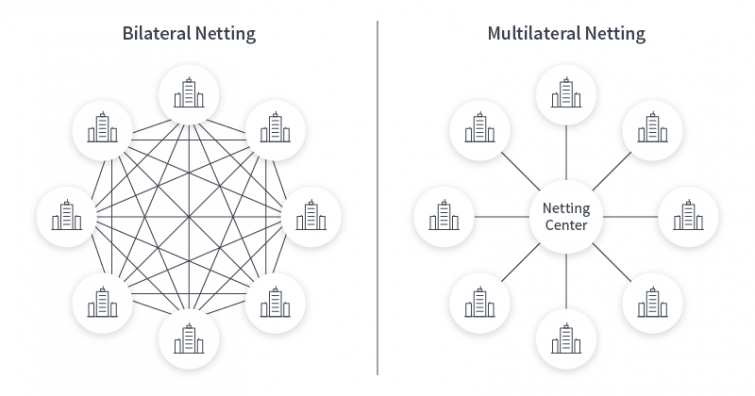Navigating Country-Specific Netting Regulations

When treasurers start talking about multilateral netting, one of the first things you hear is “we can’t net because it’s not allowed in [key office].” In every office, you’ve got someone who will mention that netting is simply impossible due to national regulations. Although sometimes there are strong rules and reporting requirements regulating netting, the fact is, netting is allowed in most nations. If you are willing to invest the effort you can net nearly every one of your offices, or at the very least involve them in the reconciliation process. However, it is important to consider the various netting regulations, and how certain countries can navigate those hurdles.
A brief definition of netting
Netting or “Intercompany Netting” is the process of reconciling and netting intercompany invoices between two parties, resulting in a final payment and netted cash flow. In regard to financial markets, the purpose is essentially to minimize transactions and distinguish remuneration in multiparty agreements. Netting is suitable for various situations, participants, and cycle types. For more information, check out our in-depth guide to netting here.
Bilateral netting: Two companies reconcile invoices they may owe to each other and one company agrees to pay the other one sum.
Multilateral netting: Three or more companies netting invoices together and a netting center is used.

Netting regulations explained
When we take a governmental approach, it makes sense for the state to impose regulatory restrictions in netting. Netting allows you to transfer money without actually transferring money, which is the core function of netting. There is no need to transfer large quantities of money around between subsidiaries or companies. You simply net balances against each other and let everyone keep whatever cash they have while trading goods and services. This opens up the potential to cheat national rules, which countries need regulations to prevent or funnel.
China, for instance, is extremely stringent on funds being transferred out of the country. With netting, one could, in theory, cheat the system to bypass this. To prevent this from happening, the Chinese central bank scrutinizes these trades with sanctions or fees.
Netting also opens up the potential for trade-based money laundering, as products shipped can be offset against trades from different countries. The West’s solution to this has been a move towards more detailed auditing. This is actually a very good policy, as netting holds all records for audits – making them easy to perform and inconsistencies easy to catch.
The final, and probably the most common issue that causes countries to put heavy regulation on netting is tax avoidance. This is the most scrutinized part of netting – for obvious reasons.
Needless to say, we don’t recommend trying any of these. The regulatory hurdles in netting that exist are fairly concrete.
A list of countries with strict netting regulations
Because of this potential for abuse, many nations have put strong regulations on netting. The specifics of what is allowed depend on the country, and we don’t claim to be experts in local laws. However, we have talked to a lot of our clients and in doing so gathered a lot of data on what is and what is not allowed. For example:
- Brazil, Malaysia, South Korea, Chile and India allow netting but only in the local currency.
- South Africa allows payables or receivables to be netted but not both. Companies wishing to net their South African subsidiaries need to be careful to make sure that their netting rules are set up for this.
- China’s desire to keep money within its borders makes netting there a difficult process; one which the central banks keep an eye on. As such, you better be ready to open your books to the central bank.
- Same with most of Eastern Europe and the Baltic States, Brazil (once again), Greece, and Japan, which all require that you open your books to the central bank.
- Many countries – including Belgium, Canada, Poland, Portugal, Lithuania, Slovenia, and Slovakia require reporting of netting.
- In Russia and Ukraine, netting can only be done on a gross-in/gross-out basis.
Of course, just because it’s allowed, doesn’t mean it’s easy – or even worthwhile for all companies – but it’s always doable for a dedicated treasurer. For example, several clients have offices across Russia and Ukraine which have implemented netting. Typically, China is seen as a lost cause for netting. However, I had a treasurer quite proudly tell me that he had worked his way through the red tape (this is often done by using a detour via Hong Kong), and their Chinese office was now fully integrated. In recent years, we’ve had nearly ¼ of our clients with Chinese offices manage to implement netting.
What if I can’t net?
In some rare cases netting isn’t allowed at all (Venezuela is the only one I can think of off the top of my head), which may tempt you to give up entirely. But while regulation may prevent your subsidiaries from being able to engage in the netting process, there are rarely – if ever – rules against involving them in the reconciliation process. Remember that the value of netting isn’t just in the cost savings from reduced transactions, but in the value that the reconciliation process brings to intercompany dealings. Reconciliation engages all parties, keeps records, and assures that deals are properly disputed. This allows you to recognize things like which parties are creating problems, and which are having shortfalls, allowing you to accurately manage and predict liquidity needs. So even if you don’t use netting, including others in the process holds value. This is why you use virtual netting. It includes all members – even those not netting – in the reconciliation process.
Many companies try to claim that they can’t net because of offices in places where netting isn’t allowed, but the truth is that netting is allowed typically everywhere with some limitations – and even in those where you can’t there is at least virtual netting. A smart treasurer will take advantage of each of these possibilities to assure that they are making the most out of their IC payables and receivables process.
Interested in finding out more about netting? Time to discover Coupa Treasury.